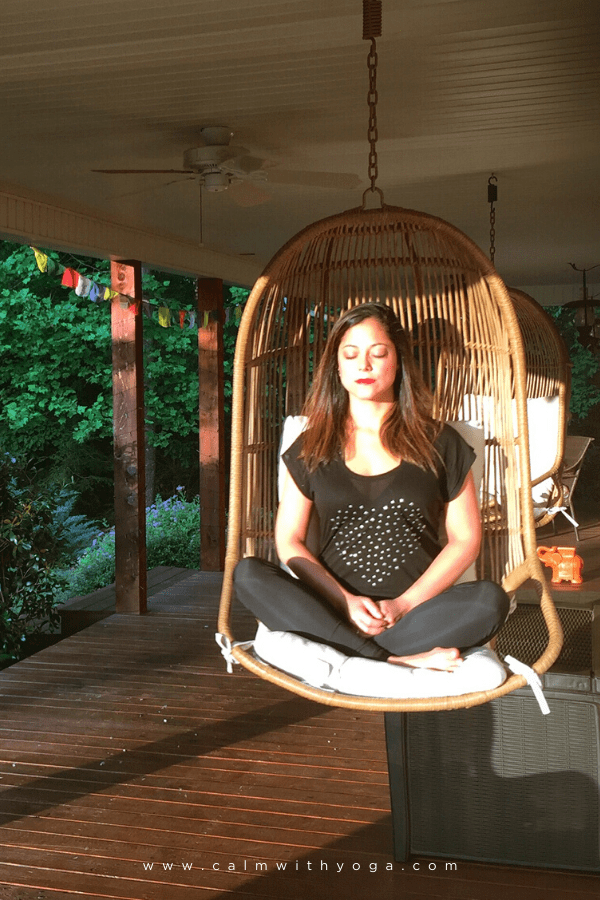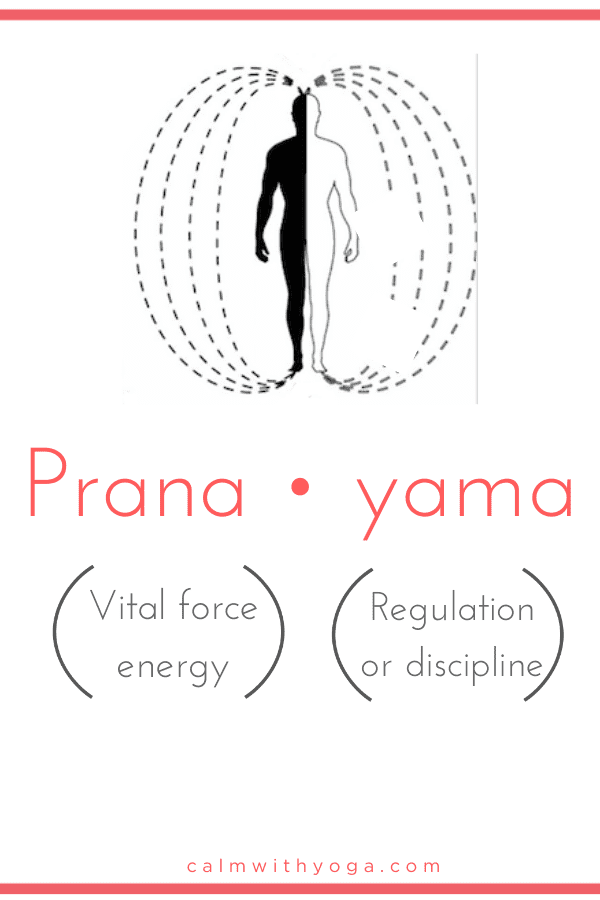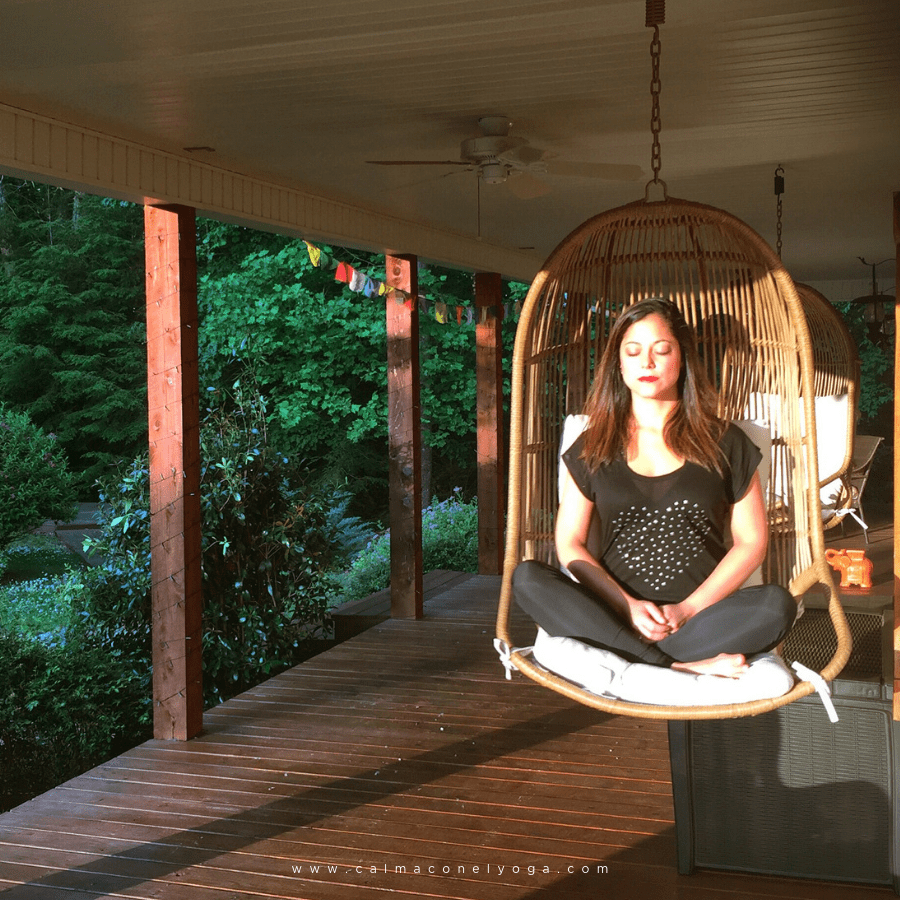If one is controlled, the other is automatically controlled as well. – Swami Satchidananda, The Yoga Sutras of Patanjali Each breath is influenced by your thoughts and emotions. And, conversely, your thoughts and emotions are influenced by the kind of breaths you take. Your breath can be an ally or a foe depending on how you use it. If you don’t learn to consciously control your breath it will control you and it will be harder to manage your mood. Most of us spend the majority of our time breathing unconsciously and erratically and in a shallow way. This sends distress signals to your mind and body which alters the way you feel and the way you perceive the world around you. This makes conditions like chronic stress, anxiety, and depression much worse. Not breathing optimally might actually be impacting your quality of life in ways you’re even not aware of…
How Yoga helped me transform panic attacks into inner calm.
This is exactly what happened to me a few years ago when I was majorly struggling with anxiety, insomnia, and chronic panic attacks. I’ve struggled with these since early childhood but things in my personal life blew up in my face and I ended up having a straight-up “dark night of the soul” moment a few years back. I found myself living alone in the middle of the North Carolina wilderness and everything intensified. I couldn’t sleep and when I finally did manage to sleep I couldn’t stay asleep unless I self-medicated. I’d wake up with dread every morning and felt like my lungs were being held captive by some invisible force that had me gasping for air. The panic attacks started getting more and more frequent and I got scared. Every time the waves of panic overtook me I felt like a prisoner in my own body as I gasped for air. My body sweating profusely, and my heart pounding intensely inside my chest. I got tired of self-medicating and seeking solace in food, alcohol, and other distractions. I knew I had to find another way because I just couldn’t keep going the way I was going. In a last-ditch effort to save myself from myself, I signed up for a yoga teacher training immersion hoping that it would help me finally feel some relief. I was a mess and felt lost, until, like a butterfly emerging from her cocoon, I finally shed various old layers of my being. I taught myself to reclaim control of my life, my body, and my mind, by first reclaiming control of my own breath. I emerged from this dark time as a renewed person, but not until I discovered the practice of Raja yoga – the yoga of the mind and emotions. Contrary to Hatha Yoga (known as the physical yoga), only a small portion of Raja Yoga is focused on the poses (asanas). And even then, the poses are really only a means to an end – a calm mind and a balanced mood.
How to reclaim control of the breath according to the Yoga Sutras:
It was during this dark time that I learned how to breathe calmly and efficiently by studying the ancient yogic wisdom that is known as Patanjali’s Yoga Sutras, the primary text of Raja yoga. The Yoga Sutras are attributed to the sage Patanjali, who, approximately 2,000 years ago, outlined what’s now known as the eight limbs of yoga (ashtanga yoga in Sanskrit) or the Yogic Path.
This form of yoga practice is intended to help us awaken understanding and insight, and cultivate the quality of calm balance regardless of outside circumstance, while also growing inner strength and resolve.
The eight limbs are: 1 – The Yamas (Self-regulating behaviors) 2- The Niyamas (Personal observances) 3- Asana (Meditational postures) 4- Pranayama (Regulation of life force energy/ kundalini via breath control) 5- Pratyahara (Drawing the senses away from the external world and towards the internal world) 6- Dharana (Sustained and one-pointed focus) 7- Dhyana (Meditation) 8- Samadhi (Transcendence of the limited mind and lower self) It was through observing the fourth limb, pranayama, that I experienced a visceral shift occurring within. The conscious attention and control of my own inhales and exhales offered me a safe place to direct my anxious and fearful energy.
The practice of pranayama is based on specific breathing techniques aimed at regulating your internal vital force energy (prana.) We can all benefit mentally, emotionally, and physically from regularly practicing pranayama techniques. And it’s much easier than you might think to get started…
A summary of the calming power of our breath according to the Yoga Sutras:
Here’s what Patanjali had to say about the power of breathing exercises… Our breath and our mental and emotional state form a feedback loop. – Sutra 1.31, Pada (Book) 1 When we experience mental or emotional stress, such as when we’re anxious or sleep deprived, our breathing becomes compromised. When our breathing becomes compromised, our bodies become compromised. And a weak or sick body or mind makes walking the eight-limbed path more challenging. Indeed, Patanjali was a sage before his time, for he knew what science has now proven: controlled, deep breathing shifts our nervous system by activating the calming, regenerating, and relaxing response while lowering the stress response. (1) – Sutra 1.34, Book 1 Controlled, prolonged exhalation, in particular, has been shown to activate our parasympathetic nervous system, the branch of our nervous system responsible for our “rest-and-digest” relaxation response. (2) Here, Patanjali outlines the parameters of a proper pranayama practice: inhaling, breath retention, and exhaling. They are to be regulated by space, time, and number and are either short or long. – Sutra 2.50, Book 2 Pranayama variations include: – where we focus our attention whilst breathing (on the breath itself, at the base of the spine, or at the heart center) – the length of time we hold the breath – the number count we inhale and/or exhale for (inhale for 5, hold for 7, exhale for 10.) This type of pranayama happens automatically and without conscious effort when we’re really engulfed and focused on something. – Sutra 2.51, Book 2 This is called kevala kumbhaka, which is the easy, unintentional retention that happens when we’re in the flow or in a deeply meditative state. In the following two sutras, Patanjali discusses the benefits of pranayama: Although it might be hard to believe at first, the simple act of regulating our own breath has the power to create small ripples of change that extend outward, eventually impacting all areas of our life. – Sutra 2.52, Book 2
This is the biggest benefit of a consistent, regular pranayama practice—the veil of mental darkness and heaviness is destroyed with every conscious breath we take.
With the removing of the veil comes a stronger presence of mind and increased mental focus and concentration, which is necessary in order to reach the eighth and final limb: Samadhi, or transcendence and union with the higher self. The mind becomes fit for concentration. – Sutra 2.53, Book 2
The portal through which we can begin to calm our anxious energy in order to transcend to higher states of being is found in our breath.
Take a beautiful full breath in by expanding your lower belly right now. Hold it for two counts and feel the infusion of vital energy filling your lungs. Exhale slowly and fully as you bring your lower belly in toward your spine. Repeat. Repeat. Repeat. Follow along with this quick guided pranayama mini-session, then end by repeating this mantra:
sat nam – I am Truth
REFERENCES : (1) https://www.researchgate.net/publication/7154990_Physiology_of_long_pranayamic_breathing_Neural_respiratory_elements_may_provide_a_mechanism_that_explains_how_slow_deep_breathing_shifts_the_autonomic_nervous_system (2) https://www.ncbi.nlm.nih.gov/pubmed/21763472



title: “The Yoga Sutras Transform Panic Into Inner Calm Motherhood Community” ShowToc: true date: “2022-12-10” author: “Barbara Cortes”
Si se controla una, la otra se controla automáticamente también. – Swami Satchidananda, Los Yoga Sutras de Patanjali Cada respiración está influenciada por tus pensamientos y emociones. Y, a la inversa, tus pensamientos y emociones están influenciados por el tipo de respiraciones que tomas. Tus inhalaciones y exhalaciones pueden ser un activo o una responsabilidad. Tu respiración puede ser un aliado o un enemigo dependiendo de cómo la uses. Si no controlas la respiración involucranado las nadi a través del pranayamah, por ejemplo, ella te controlará a ti y, por lo tanto, también a tu estado de ánimo. La mayoría de nosotras pasamos la mayor parte de nuestro tiempo respirando de manera inconsciente, errática y superficial. Ésto envía señales de angustia a tu mente y cuerpo que alteran la forma en que te sientes y la forma en que percibes el mundo que te rodea. Esto puede exacerbar condiciones como el estrés crónico, la ansiedad y la depresión. No respirar de manera óptima podría estar afectando tu calidad de vida de manera que no te das cuenta… Cómo el yoga y asana me ayudó a transformar el pánico en calma interior.
Ésto es exactamente lo que me sucedió hace unos años cuando luchaba con la ansiedad, el insomnio y los ataques crónicos de pánico. He luchado con esto desde la primera infancia, pero cosas en mi vida personal explotaron en mi cara y terminé teniendo un momento de “noche oscura del alma” en 2014. Me encontré viviendo sola en medio del desierto de Carolina del Norte y todo se intensificó. No podía dormir y cuando finalmente conseguí dormir no podía quedarme dormida a menos que me automedicara. Me despertaba con miedo todas las mañanas y sentía como si mis pulmones estuvieran cautivos por una fuerza invisible que me hacía jadear por aire. Los ataques de pánico empezaron a ser cada vez más frecuentes y me asusté. Cada vez que las olas de pánico se apoderaban de mí, me sentía como una prisionera en mi propio cuerpo mientras jadeaba en busca de aire. Mi cuerpo sudaba profusamente, y mi corazón latía intensamente dentro de mi pecho. Me cansé de automedicarme y buscar consuelo en los alimentos, el alcohol y otras distracciones. Sabía que tenía que encontrar otra manera porque simplemente no podía seguir como estaba. En un último esfuerzo por salvarme de mí misma, me inscribí en una inmersión de entrenamiento para profesores de yoga con la esperanza de que finalmente me ayudara a sentir un poco de alivio. Estaba hecha un desastre y me sentía perdida, hasta que, como una mariposa que emergía de su capullo, finalmente arrojé varias capas viejas de mi ser. Me enseñé a mí misma a reclamar el control de mi vida, mi cuerpo y mi mente, reclamando primero el control de mi propia respiración. Salí del fuego de este oscuro tiempo como una persona renovada, pero no fue hasta que descubrí la práctica del Raja yoga, el yoga de la mente y las emociones…
Cómo recuperar el control de la respiración según los Yoga Sutras de Patanjali y las Asana:
Fue durante este tiempo oscuro que aprendí a respirar con calma y eficiencia al estudiar la antigua sabiduría yóguica que se conoce como los Yoga Sutras de Patanjali, el texto principal del Raja yoga. Los Yoga Sutras of Patanjali, conocidos como patanjali’s yoga sutras, se atribuyen al sabio Patanjali, quien hace aproximadamente 2,000 años describió lo que ahora se conoce como el camino de ocho miembros o el camino del yoga.
El objetivo de este camino es ayudarnos a despertar la comprensión y la percepción, y cultivar la calidad del equilibrio tranquilo sin importar las circunstancias externas, al mismo tiempo que aumenta la fortaleza y la resolución internas.
Las ocho ramas (ashtanga yoga o limbs of yoga) son:
1 – The Yamas 2- The Niyamas 3- Asana 4- Pranayama 5- Pratyahara 6- Dharana 7- Dhyana 8- Samadhi Fue a través de la observación de la cuarta rama, pranayama, que experimenté un cambio visceral dentro de mí. La atención consciente y el control de mis propias inhalaciones y exhalaciones me ofrecieron un lugar seguro para dirigir mi energía ansiosa y temerosa.
Pranayama es un trabajo de respiración yogic, (regulation of life force energy, es decir, regulador de la energía de la fuerza/kundalini via breath control, o a través de el control de la respiración) Por otro lado, a diferencia del Hatha Yoga (conocido como el yoga físico), solo una pequeña parte del Raja Yoga se enfoca en las posturas (asanas). Todos podemos beneficiarnos mental, emocional y físicamente de una práctica más profunda de pranayama (pranayama techniques). Veamos un resumen del poder calmante de nuestra respiración de acuerdo con los Yoga Sutras de Patanjali: Nuestra respiración y nuestro estado mental y emocional forman un feedback. Cuando experimentamos angustia mental, como cuando estamos ansiosas o sin sueño, nuestra respiración se ve comprometida. Cuando nuestra respiración se compromete, nuestros cuerpos se comprometen. – Sutra 1.31, Libro 1 Y un cuerpo o mente débil o enfermo hace que caminar por el camino de las ocho ramas sea más desafiante. De hecho, Patanjali era un sabio antes de su tiempo, ya que sabía lo que la ciencia ahora ha probado: la respiración controlada y profunda cambia nuestro sistema nervioso al activar la respuesta calmante, regeneradora y relajante al tiempo que reduce la respuesta al estrés. (1) – Sutra 1.34, Libro 1. La exhalación controlada y prolongada, en particular, ha demostrado que activa nuestro sistema nervioso parasimpático, la rama de nuestro sistema nervioso responsable de nuestra respuesta de relajación de “reposo y digestión”. (2) Aquí, Patanjali describe los parámetros de una práctica adecuada de pranayama: inhalación, retención y exhalación. Deben estar reguladas por el espacio, el tiempo y el número, y son cortas o largas. – Sutra 2.50, Libro 2 Las variaciones de practice of Pranayama o pranayama practice incluyen: dónde enfocamos nuestra atención mientras respiramos (en la respiración misma, en la base de la columna vertebral o en el centro del corazón), la cantidad de tiempo que retenemos la respiración, el recuento de números que inhalamos y/o exhalamos (Inhala contando hasta 5, mantén contando hasta 7, exhala contando hasta 10). Este tipo de pranayama yoga practice ocurre automáticamente y sin esfuerzo consciente cuando realmente estamos envueltos y enfocados en algo. Esto se llama kevala kumbhaka, que es la retención fácil e involuntaria que ocurre cuando estamos en el flujo o en un estado de profunda meditación. – Sutra 2.51, Libro 2 En los siguientes dos sutras, Patanjali discute los beneficios del pranayama: Aunque puede ser difícil de creer al principio, el simple hecho de regular nuestra propia respiración tiene el poder de crear pequeñas ondas de cambio que se extienden hacia afuera, y que eventualmente impactan en todas las áreas de nuestra vida. – Sutra 2.52, Libro 2. Este es el mayor beneficio de una práctica regular y constante de pranayama: el velo de la oscuridad mental y la pesadez se destruyen con cada respiración consciente que tomamos. Eventualmente, todo lo que queda es nuestra propia luz interior, y la verdad de quiénes somos realmente está expuesta. Con la remoción del velo viene una presencia mental más fuerte y un mayor enfoque y concentración mental, que es necesario para alcanzar la octava y última extremidad: samadhi, o trascendencia y unión con el yo. – Sutra 2.53, Libro 2 El portal a través del cual podemos comenzar a calmar nuestra energía ansiosa para trascender a estados superiores de ser se encuentra en nuestra respiración. Toma una hermosa y profunda respiración expandiendo la parte inferior de tu abdomen ahora mismo. Sostenla dos veces y siente la infusión de energía vital llenando tus pulmones. Exhala lenta y completamente a medida que llevas la parte inferior del abdomen hacia tu columna vertebral. Repite. Repite. Repite. Como yoga teacher, te acosnsejo que sigas con esta rápida sesión guiada de pranayama, yoga practice, luego termina repitiendo este mantra:
sat nam – Yo Soy La Verdad
Referencias: (1) https://www.researchgate.net/publication/7154990_Physiology_of_long_pranayamic_breathing_Neural_respiratory_elements_may_provide_a_mechanism_that_explains_how_slow_deep_breathing_shifts_the_autonomic_nervous_system (2) https://www.ncbi.nlm.nih.gov/pubmed/21763472


